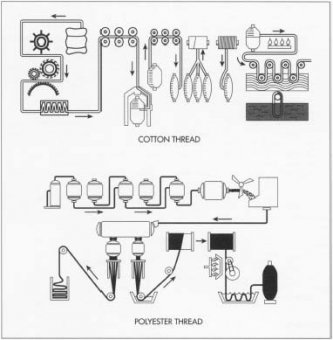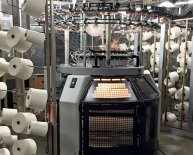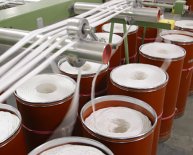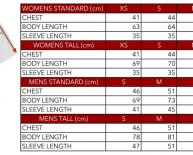
Cotton thread manufacturing process

Background
Thread is a tightly twisted strand of two or more plys of yarn that are circular when cut in cross section. It is used for hand sewing and in home sewing machines. Ninety-five percent of all sewing thread that is manufactured is used in commercial and industrial sewing. Sewing thread is distinguished from yarn by the fact that thread is used to sew together garments or other products, but yarn is the collection of fibers used to weave or knit into a textile fabric. The terms are confusing and are often used interchangeably; thread can be made of yarn, but yarn is not made of threads.
Thread is wound on spools or large cones that are marked on their ends with the size or fineness of the thread. Thread for handwork and machines (both home and commercial machines) has to be smooth and friction-free. It should be easy to thread through needles, and it should move easily when tension is applied to it. Strength to hold stitches when garments are being worn and during laundering is a requirement, as is elasticity during stitching and wear.
The three basic types of thread are based on their origin and are animal, plant, or synthetic. Silk thread is best for wools and silks (fabrics of animal origin). It is strong, very elastic, and fine in diameter. Silk is also used for tailoring, to finish the edges of buttonholes, to sew on buttons, and for decoration. Buttonhole twist is about three times the diameter of sewing silk and shiny or lustrous. It is strong and can be permanently stretched.
Cotton threads are made of the cellulose from plants and are used to stitch fabrics like linen, rayon, and cotton that also have plant origins. Plant-based fabrics may shrink, and cotton thread has the same shrinkage characteristics. Also, cotton thread does not stretch, so it is useful for woven fabrics but not stretchy knits. Cotton is also used to make basting thread that is used to hold pieces of a garment together temporarily until the garment is sewn. Cotton basting thread is inexpensive and is loosely twisted so it can be broken easily and pulled out when permanent stitching is in place.
Nylon and polyester threads are preferred for synthetics and stretch knits. Both types of synthetic threads have the same characteristics including no shrinkage, high strength, and excellent abilities to stretch and recover that make them suitable for knits, preshrunk fabrics, and sheers. Nylon and polyester are the only threads that can be made from a single yarn or single ply. Nylon thread was popular in the 1960s and 1970s because it is clear and so matches any fabric; however, nylon's stretching properties and relative brittleness also work as disadvantages, and this thread has become less popular. Synthetic threads are marketed under a variety of names including polypropylene, Kevlar, Teflon, and Nomex. Production of Kevlar and Nomex is reviewed and approved by Underwriters Laboratories because these threads are used to stitch fire-resistant and -retardant products such as suits for firefighters and motor racing drivers as well as sleepers and crib linens for infants.
Specialized thread is also treated after spinning and depending on use. Garments made of fabric treated with water repellant are also sewn with treated thread. Metallic thread is used for decoration, but it is sensitive to heat and steam and must be handled with care. Mending thread is made in the same types as those sold on spools, but it comes in short lengths so it is economical to buy a small amount. Upholstery thread is reinforced for strength so it can be used to upholster furniture. Its opposite is invisible thread that is very fine and made from nylon to be strong. Invisible thread is used to sew light- to medium-weight synthetic fabrics. Other specialized threads are made for decorative sewing like needlepoint. These include soft cotton embroidery thread, cotton perle that is twisted and has a lustrous or pearl-like finish, stranded cotton with six fine strands that can be used together or separated for finer stitching, tapestry wool for decorative work, and mending yarn for reinforcing and darning.

















